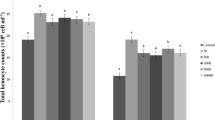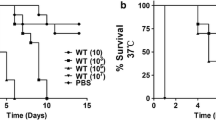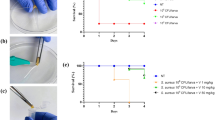Abstract
Helichrysum arenarium (L.) (Asterales:Asteraceae) Moench is a therapeutic plant which contains etheric oil, flavones and flavon glycosides, sterins, bitter substances and tannins having various coumarins. This plant is thought to have important characteristics such as diuretic effect, dropping stones and sand from the kidney, regulating digestive disorders, strengthening the immune system, and having antibiotic and antioxidant effects. Additionally, this plant is traditionally used in liver and biliary tract diseases and also shows anti-inflammatory and detoxifying properties. Model organism Galleria mellonella L. (Lepidoptera:Pyralidae) is an invertebrate species that is frequently used to study the effects of human pathogens and various pesticides, hormones, etc. on immune system. In our study, we examined the effect of various doses of H. arenarium on the hemocyte count and behavior of G. mellonella larvae. According to the findings obtained at the end of our study, H. arenarium caused an increase in hemocyte count with the injection of 0.25% and 0.5% doses compared to the untreated and DMSO groups. At the same time, the 0.25% and 0.5% doses showed a strong encapsulation-melanization response and an increase in phenoloxidase enzyme activity over 24 h compared to the other injected groups. Based on these results, H. arenarium extract has an anti-mitotic activity at high doses (above 0.5%). This effect may be due to the fact that the plant extract supports mitosis at a certain dose, while being toxic when exceeding it.


Similar content being viewed by others
Data availability
The data and material of this study can be submitted when it is necessary.
References
Aggarwal BB (2009) Targeting inflammatory pathways for chronic diseases by phytochemicals derived from spices, fruits, vegetables, and traditional remedies. Acta Hort 841:33–46
Akin M, Saki N (2019). Antimicrobial, DPPH scavenging and tyrosinase inhibitory activities of Thymus vulgaris, Helichrysum arenarium and Rosa damascena mill. ethanol extracts by using TLC bioautography and chemical screening methods. J Liq Chromatogr Relat Technol 42(7–8): 204–216
Altuntaş H, Kılıç AY, Uçkan F, Ergin E (2012) Effects of gibberellic acid on hemocytes of Galleria mellonella L. (Lepidoptera: Pyralidae). Environ Entomol 41:688–696
Ashida M, Brey PT (1998) Molecular mechanisms of immune responses in insects. (ed. Brey P., Hultmark D.) Chapman and Hall, New York, p. 135– 172
Aye M, Di Giorgio C, De Mo M, Botta A, Perrin J, Courbiere B (2010) Assessment of the genotoxicity of three cryoprotectants used for human oocyte vitrification: dimethyl sulfoxide, ethylene glycol and propylene glycol. Food Chem Toxicol 48(7):1905–1912
Balasundram N, Sundram K, Samman S (2006) Phenolic compounds in plants and agri-industrial by-products: Antioxidant activity, occurrence, and potential uses. Food Chem 99(1):191–203
Bradford MM (1976) A rapid and sensitive method for the quantitation of microgram quantities of protein utilizing the principle of protein-dye binding. Anal Biochem 72(1–2):248–254
Brookman JL, Ratcliffe NA, Rowley AF (1989) Studies on the activation of the prophenoloxidase system of insects by bacterial cell wall components. Insect Biochem 19(1):47–57
Büyükgüzel E, Büyükgüzel K, Adamski Z, Marciniak P, Ventrella E, Bufo A, Erdem M, Ziemnicki K (2013) The Influence of Diatery α-Solanine on the Waxmoth Galleria mellonella. Arch Insect Biochem Physiol 83(1):15–24
Büyükgüzel E, Büyükgüzel K, Snela M, Erdem M, Radtke K, Ziemnicki K, Adamski Z (2013) Effect of Boric Acid on Antioxidant Enzyme Activity, Lipid Peroxidation, and Ultrastructure of Midgut and Fat Body of Galleria mellonella. CellBiol Toxicol 29:117–129
Büyükgüzel K, Tunaz H, Putnam SM, Stanley DW (2002) Prostaglandin Biosynthesis by Midgut Tissue Isolated From the Tobacco Hornworm, Manduca sexta. Insect Biochem Mol Biol 32:435–443
Champion OL, Wagley S, Titball RW (2016) Galleria mellonella as a Model Host for Microbiological and Toxin Research. Virulence 7(7):840–845
Charriere JD, Imdorf A (1997) Protection of Honeycombs From Moth Damage, Swiss Bee Research Center Federal Dairy Research Station. Communication 24:16
Cook SM, McArthur JD (2013) Developing Galleria mellonella as a model host for human pathogens. Virulence 4(5):350–353
Cragg GM, Body MR, Cardell N, Grever J, Schepartz M, Spader K (1993) The role of plants in the drug discovery program of the US manuipulation.eln. International Crop Science Maddison, USA: Crop Science Society of America, 179–196
Cymborowski B (2000) Temperature-Dependent Regulatory Mechanism of Larval Development of the Wax Moth (Galleria mellonella). Acta Biochemical Polonica 47(1):215–221
Czinner E, Hagymasi K, Blazovics A, Kery A, Szoke E, Lemberkovics E (2001) The in vitro effect of Helichrysum flos on microsomal lipid peroxidation. J Ethnopharmacol 77:31–35
Dubovskiy IM, Yaroslavtseva ON, Kryukov VY, Benkovskaya GV, Glupov VV (2013) An increase in the immune system activity of the wax moth Galleria mellonella and of the Colorado potato beetle Leptinotarsa decemlineata under effect of organophosphorus insecticide. J Evol Biochem Physiol 49(6):592–596
Er A, Taşkıran D, Sak O (2017) Azadirachtin induced effects on various life history traits and cellular immune reactions of Galleria mellonella (Lepidoptera: Pyralidae). Archives of Biological Sciences 69(2):335–344
Er A, Uçkan F, River DB, Sak O (2011) Cytotoxic effects of parasitismand application of venom from the endoparasitoid Pimpla turionellae on hemocytes of the host Galleria mellonella. J Appl Entomol 136:225–236
Eroğlu EH, Hamzaoğlu E, Aksoy A, Budak Ü (2010) The genotoxic and antimitotic properties of Helichrysum plicatum herbal teas widely consumed in turkey. Caryologia 63(4):376–381
Farnsworth NR (1994) Ethnopharmacology and drug development. Ethnobotany and the search for new drugs 185:42–51
Feldhaar H, Gross R (2008) Immune reactions of insects on bacterial pathogens and mutualists. Microbes Infect 10(9):1082–1088
Frankel G, Schroeder GN (2019) The Galleria mellonella Infection Model for Investigating the Molecular Mechanisms of Legionella Virulence. In: Buchrieser C, Hilbi H (eds) Legionella. Humana Press, New York, pp 333–346
George TW, Niwat C, Waroonphan S, Gordon MH, Lovegrove JA, Paterson E (2009) Effect of chronic and acute fruit and vegetable juice consumption on cardiovascular disease risk factor. Acta Hort 841:201206
Ghahreman A (1994) Iranian choromophites (Botanical systematic). Iran University Press, Tehran, Iran, p 752
Gradinaru AC, Silion M, Trifan A, Miron A, Aprotosoaie AC (2014) Helichrysum arenarium subsp. arenarium: phenolic composition and antibacterial activity against lower respiratory tract pathogens. Natural product research 28(22):2076–2080
Hız P, Erdem M, Büyükgüzel E, Büyükgüzel K (2016) Gemifloksasinin Galleria mellonella (Lepidoptera: Pyralidae) Erginlerinin Bazı Biyolojik Özelliklerine Etkisi. Kafkas Üniversitesi Veteriner Fakültesi Dergisi 22(5):777–784
Hillyer FJ (2016) Insect immunology and hematopoiesis. Dev Comp Immunol 58:102–118
Ignasiak K, Maxwell A (2017) Galleria mellonella (greater wax moth) larvae as a model for antibiotic susceptibility testing and acute toxicity trials. BMC research notes 10(1):428
Jacobsen ID (2014) Galleria mellonella as a Model Host to Study Virulence of Candida. Journal Virulence 5(2):237–239
Jiravanichpaisal P, Lee B, Soderhall K (2006) Cell-mediated immunity in 633arthropods: Hematopoiesis, coagulation, melanization and opsonization. Immunobiology 211:213–236
Junqueira JC (2012) Galleria mellonella as a Model Host for Human Pathogens: Recent Studies and New Perspectives. Virulence 3(6):474–476
Kavanagh K, Fallon JP (2010) Galleria mellonella Larvae as Models for Studying Fungal Virulence. Fungal Biol Rev 24(1–2):79–83
Kurt D, Kayış T (2015) Effects of the pyrethroid insecticide deltamethrin on the hemocytes of Galleria mellonella. Turkish Journal of Zoology 39(3):452–457
Kutluk I, Aslan M, Orhan IE, Özçelik B (2018) Antibacterial, antifungal and antiviral bioactivities of selected Helichrysum species. S Afr J Bot 119:252–257
Lavine MD, Strand MR (2002) Insect hemocytes and their role in immunity. Insect Biochem Molec 32:1295–1309
Lazarević M, Milošević M, Petrović N, Petrović S, Damante G, Milašin J, Milovanović B (2019) Cytotoxic Effects of Different Aromatic Plants Essential Oils on Oral Squamous Cell Carcinoma-an in vitro Study. Balkan J Dent Med 23(2):73–79
Levin DM (2007) An integrin required fort he encapsulation immune response in the tobacco hornworm Manduca sexta L. (Lepidoptera: Sphingidae). PhD Thesis, Kansas State University, College of Agriculture, Department of Entomology, Manhattan, Kansas.
Ling E, Yu XQ (2005) Prophenoloxidase binds to the surface of hemocytes and is involved in hemocyte melanization in Manduca sexta. Insect Biochem Mol Biol 35(12):1356–1366
Liu Z (2008) Preparation of botanical samples for biomedical research. Endocr Metab Immune Disord Drug Targets 8(2):112–121
Liu F, Xu Q, Zhang Q, Lu A, Beerntsen BT, Ling E (2013) Hemocytes and hematopoiesis in the silkworm. Bombyx mori Invertebrate Surviv J 10(1):102–109
Lu A, Zhang Q, Zhang J, Yang B, Wu K, Xie W, Luan YX, Ling E (2014) Insect prophenoloxidase: the view beyond immunity. Frontiers in physiology 5:252
Mandato CA, Diehl-Jones WL, Moore SJ, Downer RGH (1997) The Effects of Eicosanoids Biosynthesis Inhibitors on Prophenoloxidase Activation, Phagosytosis and Cell Spreading in Galleria mellonella. J Insect Physiol 43(1):1–8
Mao Z, Gan C, Zhu J, Ma N, Wu L, Wang L, Wang X (2017) Anti-atherosclerotic activities of flavonoids from the flowers of Helichrysum arenarium L. MOENCH through the pathway of anti-inflammation. Bioorg Med Chem Lett 27(12):2812–2817
Marmaras JV, Lampropoulou M (2009) Regulators and signalling in insect haemocyte immunity. Cell Signal 21:186–195
Mastelic J, Politeo O, Jerkovic I, Radosevic N (2005) Composition and antimicrobial activity of Helichrysum italicum essential oil and its terpene and terpenoid fractions. Chem Nat Compd 41:3540
Morikawa T, Ninomiya K, Akaki J, Kakihara N, Kuramoto H, Matsumoto Y, Hayakawa T, Muraoka O, Wang LB, Wu LJ, Nakamura S, Yoshikawa M, Nakamura S (2015) Dipeptidyl peptidase-IV inhibitory activity of dimeric dihydrochalcone glycosides from flowers of Helichrysum arenarium. J Nat Med 69(4):494–506
Morikawa T, Wang LB, Nakamura S, Ninomiya K, Yokoyama E, Matsuda H, Muraoka O, Wu LJ, Yoshikawa M (2009) Medicinal flowers. XXVII. New flavanone and chalcone glycosides, arenariumosides I, II, III, and IV, and tumor necrosis factor-α inhibitors from everlasting, flowers of Helichrysum arenarium. Chem Pharm Bull 57(4):361–367
Nappi AJ, Christensen BM (2005) Melanogenesis and associated cytotoxic reactions: applications to insect innate immunity. Insect Biochem Mol Biol 35(5):443–459
Pech LL, Strand MR (1996) Granular cells are required for encapsulation of foreign targets by insect haemocytes. J Cell Sci 109:2053–2060
Pereira TC, De Barros PP, Fugisaki LRDO, Rossoni RD, Ribeiro FDC, De Menezes RT, Junqueira JC, Scorzoni L (2018) Recent advances in the use of Galleria mellonella model to study immune responses against human pathogens. Journal of Fungi 4(4):128
Pohlon E, Baldwin IT (2001) Artificial Diets ‘Capture’ the Dynamics of Jasmonate Induced Defenses in Plants. Entomol Exp Appl 100:127–130
Ribeiro C, Brehélin M (2006) Insect haemocytes: What type of cell is that. J Insect Physiol 52:417–429
Richards EH, Dani MP (2008) Biochemical isolation of an insect haemocyte anti-aggregation protein from the venom of the endoparasitic wasp, Pimpla hypochondriaca, and identification of its gene. J Insect Physiol 54:1041–1049
Richards EH, Edwards JP (2002) Parasitism of Lacanobia oleracea (Lepidoptera) by the ectoparasitic wasp, Eulophus pennicornis, disrupts the cytoskeleton of host haemocytes and suppresses encapsulation in vivo. Arch Insect Biochem Physiol 49:108–124
Rossi D, Guerrini A, Paganetto G, Bernacchia G, Conforti F, Statti G, Maietti S, Poppi I, Tacchini M, Sacchetti G (2012) Croton lechleri Müll.Arg. (Euphorbiaceae) stem bark essential oil as possible mutagen-protective food ingredient against heterocyclic amines from cooked food. Food Chem 15 (139):439–447
Rowley AF, Ratcliffe NA (1981) Insects. In: Ratcliffe NA, Rowley AF (eds) Invertebrate Blood Cells, vol 2. Academic Press, London, pp 421–488
Sak O, Uçkan F, Ergin E (2006) Effects of cypermethrin on total body weiht, glycogen, protein and lipid contents of Pimpla turionellae (L) (Hymenoptera: Ichneumonidae). Belg J Zool 136:53–58
Sheehan G, Kavanagh K (2018) Analysis of the early cellular and humoral responses of Galleria mellonella larvae to infection by Candida albicans. Virulence 9(1):163–172
Stanojković TP, Konić-Ristić A, Juranić ZD, Šavikin K, Zdunić G, Menković N, Jadranin M (2010) Cytotoxic and cell cycle effects induced by two herbal extracts on human cervix carcinoma and human breast cancer cell lines. J Med Food 13(2):291–297
Strand MR (2008) The insect cellular immune response. Insect science 15(1):1–14
Suntar I, Keles H, Yesilada E, Sarker SD (2013) Exploration of the wound healing potential of Helichrysum graveolens (Bieb) Sweet: Isolation of apigenin as an active component. J Ethnopharmacol 49:103–110
Tang F, Shen X, Gao XW (2009) In vitro inhibition of the diphenolase activity of tyrosinase by insecticides and allelochemicals in Micromelalopha troglodyta (Lepidoptera: Notodontidae). J Entomol Sci 44(2):111–119
Tunaz H, Putnam SM, Stanley DW (2002) Prostaglandin Biosynthesis by Fat Body From Larvae of the Beetle, Zophobas atratus. Arch Insect Biochem Physiol 49:80–93
Tunaz H (2004) Böceklerde Bağışıklık Mekanizması. (English: Immune mechanism in insects) KSÜ Fen ve Mühendislik Dergisi 7(2):78–8
Tunaz H, Park Y, Büyükgüzel K, Bedick JC, Nor Aliza AR, Stanley DW (2003) Eicosanoids in insect immunity: Bacterial infection stimulates hemocytic phospholipase A2 activity in Tobacco hornworms. Arch Insect Biochem Physiol 52(1):1–6
Vilmos P, Kurucz E (1998) Insect immunity: evolutionary roots of the mammalian innate immune system. Immunol Lett 62:59–66
Yuan H, Ma Q, Ye L, Piao G (2016) The traditional medicine and modern medicine from natural products. Molecules 21(5):559
Wang CL, Wang ZX, Kariuki MM, Ling QZ, Kiguchi K, Ling EJ (2010) Physiological functions of hemocytes newly emerged from the cultured hematopoietic organs in the silkworm. Bombyx mori Insect Science 17(1):7–20
Wu G, Liua Y, Ding Y, Yi Y (2016) Ultrastructural and functional characterization of circulating hemocytes from Galleria mellonella larva: Cell types and their role in the innate immunity. Tissue Cell 48:297–304
Wu G, Yi Y (2015) Effects of dietary heavy metals on the immune and antioxidant systems of Galleria mellonella larvae. Comp Biochem Physiol C: Toxicol Pharmacol 167:131–139
Author information
Authors and Affiliations
Corresponding author
Ethics declarations
Conflicts of interest
The authors declare that they have no conflict of interest.
Consent to participate
All of the authors accepted to participate in this study
Consent for publication
All of the authors accepted to publishing of this study in this Journal.
Rights and permissions
About this article
Cite this article
Kaya, S., Akkuş, G., Türkdoğan, S. et al. Influence of Helichrysum arenarium on hemocyte-mediated immune responses and phenoloxidase enzyme activity of model organism Galleria mellonella (L.). Int J Trop Insect Sci 41, 2521–2528 (2021). https://doi.org/10.1007/s42690-021-00432-8
Received:
Accepted:
Published:
Issue Date:
DOI: https://doi.org/10.1007/s42690-021-00432-8




